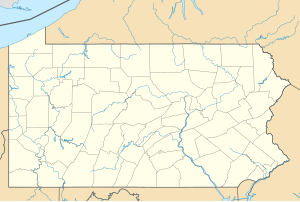| Upper Pine Bottom State Park | |
|---|---|
 Upper Pine Bottom State Park was a Bureau of Forests picnic area until its 1962 transfer to the Bureau of State Parks. | |
| Location | Cummings, Lycoming, Pennsylvania, United States |
| Coordinates | 41°19′05″N 77°25′17″W / 41.318°N 77.4214°W[1] |
| Area | 5 acres (2.0 ha)[2] |
| Elevation | 932 ft (284 m)[1] |
| Established | 1923 |
| Named for | Upper Pine Bottom Run |
| Governing body | Pennsylvania Department of Conservation and Natural Resources |
| Website | dcnr |
Upper Pine Bottom State Park is a 5-acre (2.0 ha) Pennsylvania state park in Lycoming County, Pennsylvania in the United States. The park is in Cummings Township on Pennsylvania Route 44 and is surrounded by the Tiadaghton State Forest. It is on Upper Pine Bottom Run, which gave the park its name and is a tributary of Pine Creek. Upper Pine Bottom State Park is in the Pine Creek Gorge, where the streams have cut through five major rock formations from the Devonian and Carboniferous periods.
The earliest recorded inhabitants of the area were the Susquehannocks, followed by the Iroquois, Lenape, and Shawnee. Upper Pine Bottom Run was the site of a furnace for pig iron in 1814, the first sawmill was built on it in 1815, and in 1825 an earlier bridle path across its headwaters became a turnpike. The lumber industry led to the clearcutting of the area in the 19th century. The state forest was started in 1898 and the park was formed from it by 1923 as a Class B public camp. The Civilian Conservation Corps had a camp on the run and improved the park in the 1930s, but it was not transferred to the Bureau of State Parks until 1962. Though it began as a public campsite and once had a picnic pavilion, as of 2017[update] it is for day use only and its only facilities are a few picnic tables and a parking area.
Upper Pine Bottom State Park is one of the smallest state parks in Pennsylvania, and is maintained by staff from nearby Little Pine State Park. In addition to picnics, its chief use is as a parking area for local hunters, anglers, hikers, cross-country skiers, snowmobilers, and all-terrain vehicle riders. Upper Pine Bottom Run is state-approved and stocked for trout fishing in season. Second-growth forest now covers the region; the surrounding state forest and park are home to a variety of flora and fauna.

